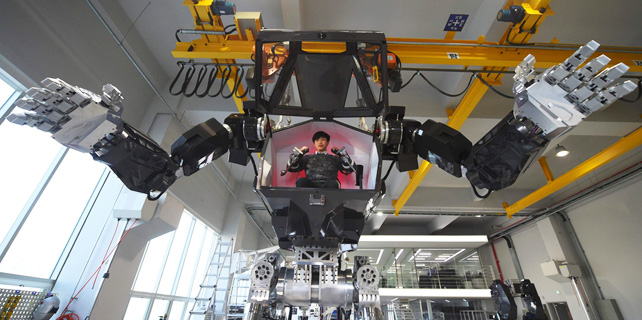Superior tech, stronger brands needed
China has advocated innovation as a way to renew growth in the volatile global economy. Innovation will also act as a signal to the rest of the world that China is joining the ranks of the industrialized countries, which have historically relied on innovation to drive their growth.
Advances in science are an important source of innovation. With continuous and heavy investment in research and development by both the government and high technology companies over the several decades, China's innovation capabilities are growing at an accelerated pace, and a number of technological breakthroughs have emerged.
Examples of such high-tech companies include Tencent, one of the largest Internet companies in the world; Huawei, the largest telecommunications company in the world; and CRRC Corp, the largest railway vehicle manufacturer in the world. As these examples indicate, in some areas Chinese companies have completed their journey from catching up to leading the innovation race at the cutting edge of scientific development.

Significantly, China has outperformed other emerging economies, such as India and Brazil, in innovation. According to the latest Global Innovation Index released jointly by Cornell University, INSEAD and the World Intellectual Property Organization, in 2016, China joined the ranks of the world's 25 most-innovative economies. Switzerland, Sweden, the United Kingdom, the United States, Finland and Singapore were in the lead. This is the first time a middle-income country has joined the highly developed economies that have historically dominated the top of the GII.
This remarkable achievement has attracted much attention from Western scholars and policymakers, who are trying to understand the key ingredients that characterize the Chinese model of innovation. However, even within China, there is no clear definition of what the Chinese model is. The rise of high-profile e-commerce companies such as Alibaba and the on going problems it has with counterfeit goods only confound matters further, resulting in questions as to whether any truly innovative model actually exists in China.
A related question is the trajectory of innovation, as the country aspires to move upward to join the advanced economies. There is a strong sense of urgency in China to move upward rather than stagnate, which has caused excitement and fear in equal measure among scholars, companies and policymakers.
The country is once again at a crossroads, as it was more than 30 years ago when the opening-up policy and reform first began. But this time China needs a very different set of capabilities to succeed. After three decades of double digit growth, propelled by the combination of an abundant supply of cheap labor and large flows of inward foreign direct investment, growth is slowing and stagnating as these advantages disappear.
In November 2016 I attended a research forum on innovation. Like many forums in China, it raised important questions and provided a platform for knowledge-sharing. This article is an attempt to reflect on these discussions and provide some initial thoughts based on my research findings.
In the past 30 years, China's technological development has evolved from learning through technology transfer, reverse engineering and imitation to disruptive innovation and customer-led innovation. These models relied on rapid technological learning and absorption capacity and created value for Western clients as original-equipment manufacturers and for their domestic customers who demanded low-cost products with strong functionality.
This development trajectory has been examined thoroughly and understood by most Western scholars studying China. However, as leading Western companies such as Ericsson and Facebook wake up to the shocks of Huawei becoming the world's top telecom supplier, Tencent's versatile social network platform WeChat competing for the dominant position, and the use of robots to deliver parcels by Shunfeng Courier Services, Western scholars are puzzled as to why some Chinese companies such as Huawei, Tencent and CRRC can break away from the traditional path-dependent trajectory of development to become truly innovative companies on the world stage.
To solve this puzzle, one has to turn to the unique geographic, demographic and cultural formation of the country. It would be over-simplistic to describe China as a single market with 1.4 billion consumers. It would be equally ignorant to comprehend the country merely as a combination of dissimilar and disconnected regions. Despite their similarity in terms of the size of territories, it would be misleading to compare the US market with the Chinese market. The different layers of income and population density of Chinese cities and towns, combined with the cultural characteristics of interdependence, inner drive and tolerance, create a unique ecosystem that opens up multiple opportunities for Chinese companies to compete based on differential advantages.
For example, for many Chinese companies low cost is the main competitive advantage. These companies have access to low-cost labor as well as a sufficiently large segment of domestic customers who are cost-conscious. However, Chinese companies have sufficient economies of scale and scope to experiment in different geographic regions and in different market segments to gradually proceed up the quality ladder and fulfill different needs, from utilitarian to hedonic.
Companies like Huawei applied the strategy internationally by starting in developing markets like Africa and gradually moving to advanced regions like Europe. Having achieved a leading position globally, companies like Huawei will need to rely more on basic scientific research in areas such as artificial intelligence to keep competitors at bay.
In addition, as the country's economy is slowing down and with air quality worsening and regulations tightening, many companies are investing abroad to deploy excess capacity, manage risk and access global market opportunities. This requires Chinese companies to work in a very different institutional and cultural environment, which requires a different set of core capabilities, including innovative capabilities, coordination capabilities, marketing communication capabilities and corporate social responsibilities.
Another challenge facing the Chinese economy is the role of government. Historically, the Chinese government has played a key role in terms of policy incentives and financial investment in developing innovation capabilities. However, the results have been very mixed, with state-owned enterprises, research institutes and universities benefiting most from these incentives, whereas private enterprises have very limited access to resources.
The recent policy of the government has been to change from the top-down planned approach to a bottom-up entrepreneurial approach. This is a significant policy shift, but for it to become embedded it needs a new ecosystem in which access to finance by private and startup companies can be provided.
More fundamentally the country's education system needs a total revamp as it is outdated and geared toward passing exams rather than nurturing creative talent.
Finally, and most important, after 30 years of accumulated wealth, the new Chinese middle class and its need for hedonic satisfaction and affirmation of self-identity can no longer be ignored. This segment of society will be the new engine for growth as the desire of its members to perfect themselves in all areas of their lives is insatiable and they are the most discerning customers in terms of quality, style and taste.
This is particularly challenging for the traditional model of innovation, where the focus is on reducing cost and increasing efficiency rather than on superior quality and emotional connection with customers. This is a huge gap for China, and so far it has been filled almost entirely by Western brands such as Apple, BMW and Hermes, to name just a few.
This is because, while the demand side has shifted from low cost to high-quality products, the supply side is still trapped by a low-cost production model, resulting in a mismatch between demand and supply. The value of innovation is to identify and satisfy the latent needs of sophisticated customers in China and worldwide.
This requires both the tangible asset of intellectual property and intangible asset of brands. Looking around, the most innovative companies are also the best known brands and this is no coincidence. It is in this respect that the gap between China and the West is most pronounced.
According to Interbrand's 2016 best global brands ranking, the top 100 most-valued brand positions are almost completely occupied by Western brands, with the exception of Huawei (No 72) and Lenovo (No 99).
Statistics differ, but overall they agree that, although the quality of output varies, China has significantly increased its R&D spending and the number of IPR and scientific publications. However, China significantly lags in terms of the number of global brands.
Brand-building requires a different mindset from that of low-cost production. A brand not only provides new functions but also tells a story that is meaningful and memorable, thus communicating unique value and ensuring customer loyalty.
Brands are the embodiment of culture and rooted in heritage and history. They require confidence in one's cultural identity and history. China's economic success has brought about renewed confidence and interest in Chinese culture. Therefore, it is time to develop strong brands. A strong brand brings out the best of the culture of its country of origin, thus increasing the soft power of the country and its influence in the world stage.
A new ecosystem of innovation is therefore required to break the path of dependency on the traditional innovation model to combine technological superiority with strong brand building.
Qing Wang, professor of Marketing and Innovation, Warwick Business School, University of Warwick, UK. The views do not necessarily reflect those of China Daily.
( China Daily European Weekly 12/30/2016 page12)


















